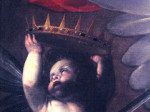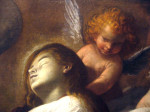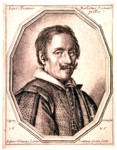


Giovanni Baglione
Italian, 1573-1644
St. Catherine of Alexandria Carried to Her Tomb by Angels, 17th c. CE ca.
oil on canvas
49 1/2 x 65 1/8 in.
SBMA, Museum purchase, The Suzette and Eugene Davidson Fund
1985.40

Portrait of Giovanni Baglione, painted in 1625 by Ottavio Leoni, Italian, 1578 - 1630, engraving and stipple with etching, Fine Arts Museums of San Francisco
RESEARCH PAPER
[St. Catherine of Alexandria Transported by Angels, ca. 1603, was the title used in 1987 when this paper was written.]
St. Catherine of Alexandria Transported by Angels was painted in oils by Giovanni Baglione in ca. 1603 and executed in a style attributed to the influence of Caravaggio. The large-scale complex composition is rendered in warm glowing colors and depicts the martyred St. Catherine in death lovingly attended by angels. On examination in 1985 by a local conservation laboratory, the painting was deemed to be in good condition. Two different periods of retouching -- including in-painting, treatment of rips, filling of paint losses and lining -- were observed to have been expertly done. The work was purchased in 1985 from Piero Corsini Gallery of New York through the Suzette and Eugene Davidson Acquisition Fund.
In the early 17th century, the painting was known to be in the collection of Nicolas Regnier, a French artist then living in Venice. In 1637 it was purchased by the Duke of Hamilton, and twelve years later sold to Leopold Wilhelm, an Austrian archduke, where it remained in his possession until 1659, From 1660 on, its provenance is unknown, until its discovery at the Corsini Gallery in this century.
In order to understand how the sociopolitical unrest was affecting the work of artists in the 17th century, we must take a look at the catastrophic events that were shaking Europe in the 16th century. All aspects of life were undergoing re-examination and radical change. The religious zeal of Martin Luther and John Calvin divided the Continent into Reformation and Counter-Reformation camps. To meet the challenge of the Reformation, the Council of Trent was meeting intermittently from 1545 to 1563, resulting in great reforms within the Church and leading to a stricter church doctrine. The lives and attitudes of Counter-Reformation artists were greatly affected by the new religious climate in which art was rewed to the Church and the clergy were responsible for the development of religious art. This was a time of immense building programs -- of palaces, churches and chapels, many dedicated to the founders of the new Counter-Reformation religious orders. Large commissions were forthcoming for the prominent artists of the time. Immediately following the closing of the Council of Trent and throughout the 1570's and '80s, avant-garde artists were effecting a style based on observation of nature and resulting in works which were intelligible to the beholder. While one aspect of Mannerism adapted and extended the ideals of the High Renaissance, another more striking aspect of Mannerism was the violent reaction to rules, with a bold and dramatic departure from naturalism toward freer p1ay of imagination, spatial ambiguities of tightly compressed or rapidly receding settings, exaggerated perspective and often contorted poses. Renaissance classical harmony, clarity and order were giving way to confused and conflicting compositional elements.
During this time, the tradition of Mannerism came under attack and an important figure in the movement to a new style was Caravaggio. That quality of Caravaggio's work which excited most comment from 17th century writers was his manipulation of light effects. Caravaggio mastered a technical ability that could boast brilliant effects of light, extreme and momentary expression and arrested movement, without sacrificing clarity of design. His preference for life-size figures, suppression of extraneous detail, and dramatic focus of attention also qualify his work. Although his flamboyant personality and reputation as an artist overshadowed other painters of this period, his innovative manner captured the attention of many of them and a movement known as Caravaggism arose during the first decade of the 17th century, centered in Rome and later extended throughout Europe. By 1620 Caravaggism was a fairly definite style of painting, marked by characteristic subject matter and form.
Giovanni Baglione was one of the first artists to experiment with the bold and innovative style of Caravaggio. Trained by a minor Tuscan artist, Francesco Morelli, his style developed in Florentine school in Rome where he studied under Cavalier d'Arpino. In the late 1580's he contributed frescoes to the Vatican Library in a Mannerist style closely related to d'Arpino's. By the end of the 16th century, he had been awarded many commissions by Pope Clement VIII, and in 1600 he was assigned a major fresco in S. Giovanni in Laterno, the Donation of Constantine. In the ensuing three years, Baglione painted at least four altar pieces for Cardinal Sfondrato in S. Cecilia in Trastevere, and a major altarpiece, the Resurrection, was done for the Gesu.
Ca. 1600, Baglione had radically altered his style under the influence of Caravaggio's art. His Ecstasy of St. Francis (1601) is the first Caravaggesque painting that is known to us and is now in a private collection in Santa Barbara. In this painting, the bold light and strong chiaroscuro, the deep unbroken colors and the figure types, especially of the angels, reveal Baglione's admiration for Caravaggio's art. Baglione's St. Francis seems more Manneristic as compared to Caravaggio's St. Francis, in that the figures seem to be flattened against the picture plane in an almost two-dimensional effect. His paintings between 1600 - 1605 are not consistently Caravaggesque, although the St. Sebastian Healed by an Angel and the second version of Divine Love, which is presumed to be the rival of Caravaggio's Victorious Love, are derivative of Caravaggism. The subject of the work St. Catherine of Alexandria was identified by Professa Mina Gregori and she has attributed it to Baglione's Caravaggesque period. It is felt that this composition, previously unknown, is remarkably similar to the St. Sebastian and Ecstasy of St. Francis mentioned above. In all three works the figure appears in a state of rapture, with the head bent back in a swoon and eyes slightly or fully closed. Identical facial features of the angels showing heavy eyelids, full lips, and hair falling around their broad faces are seen in all three paintings. The similarities suggest that the present work was painted before the end of 1603.
Caravaggio apparently greatly resented the competition from Baglione and specifically for imitating his style. He reacted with such resentment as to claim that Baglione was incompetent as a painter, and further harshly criticized his Resurrection publicly. These public criticisms, as well as scurrilous verses written about him, resulted in Baglione filing a suit of libel. The lawsuit ended inconclusively and following that process, Baglione used the style of the master only occasionally, although later paintings are not entirely free of Caravaggesque influence.
Baglione's painting career came to an end probably by 1639, when he turned to writing. He published "New Churches of Rome", followed by the "Lives of Painters, Sculptors and Architects". The latter was a primary authoritative work on the biography of artists in the late 16th to middle 17th centuries.
The subject of the painting St. Catherine of Alexandria Transported by Angels is based on the legend of St. Catherine. As the legend goes, St. Catherine was a very learned and persuasive noblewoman who lived during the 3rd century. So successful was she in converting subjects to Christianity that Gov. Mazimin II sentenced her to death on the wheel. The wheel supposedly was broken by divine intervention and, unfortunately, she was further sentenced to die by beheading. We see evidence of a wooden fragment (the wheel) in the left side of the painting, as well as the sword (the instrument of her death). A small cherubic angel holds a crown, attesting to her martyrdom. The foreground figure of an angel with spread wings is emphasized over the main subject, and two other angels encircling her with tender gestures and loving expressions emphasize the spiritual nature of St. Catherine. Our eyes are drawn to the ashen face of St. Catherine as she lies sublimely in death, waiting to be carried by her heavenly attendants to her tomb. The dark purple of her robe bespeaks her royalty, and the overall warm glow of colors diffused by a heavenly light reveal to us her sainthood.
Prepared for the Santa Barbara Museum of Art Docent Council by Phyllis Crawford, April, 1987.
Prepared for the website by Loree Gold, November, 2005.
BIBLIOGRAPHY
Books:
Benezit, E. Dictionnaire Des Peintres, Sculpteurs, Dessinateurs, et Graveurs. Paris: Librairie Grund, 1976.
Havlice, Patricia Pate. World Painting Index, vol. 1. Metuchen, N.J. and London: Scarecrow Press, Inc., 1977.
Moir, Alfred. The Italian Followers of Caravaggio, vol. 1. Cambridge, Mass: Harvard University Press, 1967, pp. 269-285.
Moir, Alfred. The Italian Followers of Caravaggio, vol. 2.
Spear, Richard E. Caravaggio and His Followers. First icon edition (rev.). New York: Harper & Row, 1975.
Exhibition Catalogue:
Piero Corsini, Inc., New York. Italian Old Master Paintings: Fourteenth to Eighteenth Century, Nov. 17 to Dec. 8,1984.
Audio-tape:
Henning, Robert. Art a la Carte lecture, "Once a Saint, Always a Saint". Santa Barbara Museum of Art, Nov. 1985. (Tape #71).
SBMA CURATORIAL LABELS
Beginning in the late 16th century, the fathers of the Catholic Church made an official appeal to artists to use their skills to produce art that would stir the emotions of the faithful. Religious images were understood to be powerful weapons in the campaign to counteract the success of the Protestant Reformation.
This painting is a beautiful example of a Counter-Reformation image. Earlier images of St. Catherine always showed her as a lovely, vital young princess, often standing beside the spiked wheel on which she would be tortured. Here she is instead presented as lifeless, in the arms of a mournful, loving angel who is about to transport her to heaven. Two other angels descend with her martyr’s palm and crown.
The appeal to our emotions is heightened by the dramatic use of light and shadow, and the way Baglione places the figures so intimately close to our space. She is literally being held up for us, too, to gaze upon with sorrow, to ponder the tragedy of her sacrifice for her faith.
- Botticelli, Titian, and Beyond, 2015 & Ludington Court Reopening, 2021
